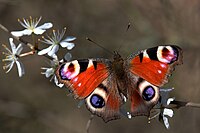
Photo from wikipedia
Abstract Most moths and butterflies of medical-veterinary importance are members of the following four superfamilies: Bombycoidea, Noctuoidea, Papilionoidea, and Zygaenoidea. At least 14 families, representing more than 100 species worldwide,… Click to show full abstract
Abstract Most moths and butterflies of medical-veterinary importance are members of the following four superfamilies: Bombycoidea, Noctuoidea, Papilionoidea, and Zygaenoidea. At least 14 families, representing more than 100 species worldwide, have caterpillars (larvae) with stinging hairs or spines than can cause dermatitis (urticaria) upon contact with the skin. Adult moths also can pose health concerns by irritating eye tissues while feeding at night on tears (lachrymal secretions) of domestic and wild animals; feeding on fluids associated with open wounds; and in some cases actually piercing the skin with their proboscis to feed on blood. Air-borne wing scales of adults can cause inhalation allergies, in addition to the cocoon silk of certain moths causing silk-induced allergies. Among the more important veterinary problems are caterpillar-induced equine abortion and mare reproductive loss syndrome (equine amnionitis and fetal loss) following ingestion of certain species of caterpillars infesting pastures and browse areas.
Journal Title: Medical and Veterinary Entomology
Year Published: 2019
Link to full text (if available)
Share on Social Media: Sign Up to like & get
recommendations!